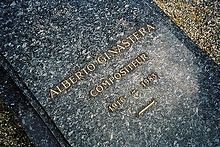Alberto Ginastera
Alberto Evaristo Ginastera (born April 11, 1916 in Buenos Aires , † June 25, 1983 in Geneva ) was an Argentine composer .
Life
Ginastera studied at Williams - Conservatory in Buenos Aires; he graduated in 1938. He then directed the La Plata Conservatory, which he founded . Until 1962 he taught at the Art and Music Faculty of the Catholic University of Buenos Aires, then at the Centro Latinoamericano de Altos Estudios Musicales (CLAEM). In 1965 Ginastera was elected to the American Academy of Arts and Sciences and in 1968 to the American Academy of Arts and Letters . In 1971 he moved to the Switzerland to Geneva.
Ginastera composed four operas , two ballets , three motets , songs , stage and film music , as well as a symphony , an overture , three string quartets , a harp - and a violin concerto , two piano - and two cello concertos , three piano sonatas and other instrumental music.
Beyond classical music, his toccata (from the fourth movement of his Piano Concerto No. 1) became known in the adaptation of the music group Emerson, Lake and Palmer on their album Brain Salad Surgery (1973).
In “ Popol Vuh ”, the “Book of Council”, the Maya tell their version of the creation of the world. Ginastera was inspired by this text for his composition of the same name and began to work on an eight-part orchestral work. His death prevented the completion of the last section.
The grave of Alberto Ginastera is in the Cimetière des Rois cemetery in Geneva.
music
In his music, Alberto Ginastera combined traditional rhythms of Argentine folklore (e.g. Chacarera and Malambo ) with the harmony of modern classical music - a combination that is reminiscent of the music of Béla Bartók due to the rhythmic conciseness and the free tonality . In Ginastera's music, dissonances and modal tonality do not play the same role as, for example, in the 12-tone music by Arnold Schönberg . His compositions usually show a clear structure, which even a layman can at least intuitively understand, be it motivic , melodic or harmonic . A good example of this is the third movement of the three Danzas argentinas op. 2 from 1937.
Works (selection)
- Panambí op. 1, ballet (1934–37)
- Danzas argentinas op. 2 (1937) (Danza del viejo boyero - Danza de la moza donosa - Danza del gaucho matrero)
- Malambo op.7 (1940)
- Estancia op.8 , ballet (first performance of the suite in 1943, of the ballet in 1952)
- 3 Danzas de la Estancia op.8 (1941)
- Obertura para el “Fausto” criollo op. 9 (1943)
- 5 canciones populares argentinas for voice and piano op.10 (1943)
- 12 Preludios americanos op.12 (1944)
- String Quartet No. 1 op.20 (1948)
- Piano Sonata No. 1 op.22 (1952)
- Harp Concerto op.25 (1956–65)
- Piano Concerto No. 1 op.28 (1961)
- Don Rodrigo op.31, opera (1963/64)
- Bomarzo op.34 , opera (1966/67)
- Beatrix Cenci op.38 , opera (1971)
- Piano Concerto No. 2, Op. 39 (1972)
- Popol Vuh op.44 (1975-83)
- Sonata for Guitar op.47 (1976, rev. 1981), first performed by Carlos Barbosa-Lima
- Piano Sonata No. 2 op.53 (1981)
- Piano Sonata No. 3 op.55 (1982)
Filmography (selection)
- 1958: It happened on a spring night (Livets vår)
- 1988: Room 36
Web links
- Works by and about Alberto Ginastera in the catalog of the German National Library
- Alberto Ginastera in the Internet Movie Database (English)
- Publishing information for Alberto Ginastera at Boosey & Hawkes
Individual evidence
- ↑ Book of Members 1780 – present, Chapter G. (PDF; 931 kB) In: American Academy of Arts and Sciences (amacad.org). Retrieved March 11, 2019 .
- ↑ Honorary Members: Alberto Ginastera. American Academy of Arts and Letters, accessed March 11, 2019 .
| personal data | |
|---|---|
| SURNAME | Ginastera, Alberto |
| ALTERNATIVE NAMES | Ginastera, Alberto Evaristo (full name) |
| BRIEF DESCRIPTION | Argentine composer |
| DATE OF BIRTH | April 11, 1916 |
| PLACE OF BIRTH | Buenos Aires , Argentina |
| DATE OF DEATH | June 25, 1983 |
| Place of death | Geneva , Switzerland |
